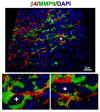MMP9 cleavage of the β4 integrin ectodomain leads to recurrent epithelial erosions in mice
- PMID: 21750188
- PMCID: PMC3138707
- DOI: 10.1242/jcs.085480
MMP9 cleavage of the β4 integrin ectodomain leads to recurrent epithelial erosions in mice
Abstract
Integrin α6β4 is an integral membrane protein within hemidesmosomes and it mediates adhesion of epithelial cells to their underlying basement membrane. During wound healing, disassembly of hemidesmosomes must occur for sheet movement-mediated cell migration. The mechanisms of disassembly and reassembly of hemidesmosomes are not fully understood. The current study was initiated to understand the underlying cause of recurrent corneal erosions in the mouse. Here, we show that in vivo: (1) MMP9 levels are elevated and β4 integrin is partially cleaved in epithelial cell extracts derived from debridement wounded corneas; (2) the β4 ectodomain is missing from sites where erosions develop; and (3) β4 cleavage can be reduced by inhibiting MMP activity. Although β4, α3 and β1 integrins were all cleaved by several MMPs, only MMP9 was elevated in cell extracts derived from corneas with erosions. Coimmunoprecipitation studies showed that β4 integrin associates with MMP9, and protein clustering during immunoprecipitation induced proteolytic cleavage of the β4 integrin extracellular domain, generating a 100 kDa β4 integrin cytoplasmic domain fragment. Confocal imaging with three-dimensional reconstruction showed that MMP9 localizes at erosion sites in vivo where the ectodomain of β4 integrin is reduced or absent. MMP activation experiments using cultured corneal and epidermal keratinocytes showed reduced levels of α6β4 and β1 integrins within 20 minutes of phorbol ester treatment. This report is the first to show that β4 integrin associates with MMP9 and that its ectodomain is a target for cleavage by MMP9 in vivo under pathological conditions.
Figures







Similar articles
-
Keratinocytes display normal proliferation, survival and differentiation in conditional beta4-integrin knockout mice.J Cell Sci. 2005 Mar 1;118(Pt 5):1045-60. doi: 10.1242/jcs.01689. J Cell Sci. 2005. PMID: 15731010
-
Integrin beta4, keratinocytes and papillomavirus infection.Int J Mol Med. 2006 Feb;17(2):195-202. Int J Mol Med. 2006. PMID: 16391815 Review.
-
A mouse model for the study of recurrent corneal epithelial erosions: alpha9beta1 integrin implicated in progression of the disease.Invest Ophthalmol Vis Sci. 2004 Jun;45(6):1775-88. doi: 10.1167/iovs.03-1194. Invest Ophthalmol Vis Sci. 2004. PMID: 15161840
-
Removal of the basement membrane enhances corneal wound healing.Exp Eye Res. 2011 Dec;93(6):927-36. doi: 10.1016/j.exer.2011.10.012. Epub 2011 Nov 2. Exp Eye Res. 2011. PMID: 22067129 Free PMC article.
-
Integrins in slow-cycling corneal epithelial cells at the limbus in the mouse.Stem Cells. 2006 Apr;24(4):1075-86. doi: 10.1634/stemcells.2005-0382. Epub 2005 Nov 10. Stem Cells. 2006. PMID: 16282441
Cited by
-
Corneal Epithelial Abrasion with Ocular Burr As a Model for Cornea Wound Healing.J Vis Exp. 2018 Jul 10;(137):58071. doi: 10.3791/58071. J Vis Exp. 2018. PMID: 30059040 Free PMC article.
-
Partial denervation of sub-basal axons persists following debridement wounds to the mouse cornea.Lab Invest. 2015 Nov;95(11):1305-18. doi: 10.1038/labinvest.2015.113. Epub 2015 Aug 17. Lab Invest. 2015. PMID: 26280222 Free PMC article.
-
Loss of MMP-8 in ductal carcinoma in situ (DCIS)-associated myoepithelial cells contributes to tumour promotion through altered adhesive and proteolytic function.Breast Cancer Res. 2017 Mar 23;19(1):33. doi: 10.1186/s13058-017-0822-9. Breast Cancer Res. 2017. PMID: 28330493 Free PMC article.
-
A Scoping Review of the Role of Metalloproteinases in the Pathogenesis of Autoimmune Pemphigus and Pemphigoid.Biomolecules. 2021 Oct 13;11(10):1506. doi: 10.3390/biom11101506. Biomolecules. 2021. PMID: 34680139 Free PMC article.
-
Matrix Dynamics and Microbiome Crosstalk: Matrix Metalloproteinases as Key Players in Disease and Therapy.Int J Mol Sci. 2025 Apr 11;26(8):3621. doi: 10.3390/ijms26083621. Int J Mol Sci. 2025. PMID: 40332093 Free PMC article. Review.
References
-
- Borradori L., Sonnenberg A. (1996). Hemidesmosomes: roles in adhesion, signaling and human diseases. Curr. Opin. Cell Biol. 8, 647-656 - PubMed
-
- Choi W. S., Jeon O. H., Kim D. S. (2010). CD40 ligand shedding is regulated by interaction between matrix metalloproteinase-2 and platelet integrin αIIbβ3. J. Thromb. Haemost. 8, 1364-1371 - PubMed
Publication types
MeSH terms
Substances
Grants and funding
LinkOut - more resources
Full Text Sources
Research Materials
Miscellaneous

